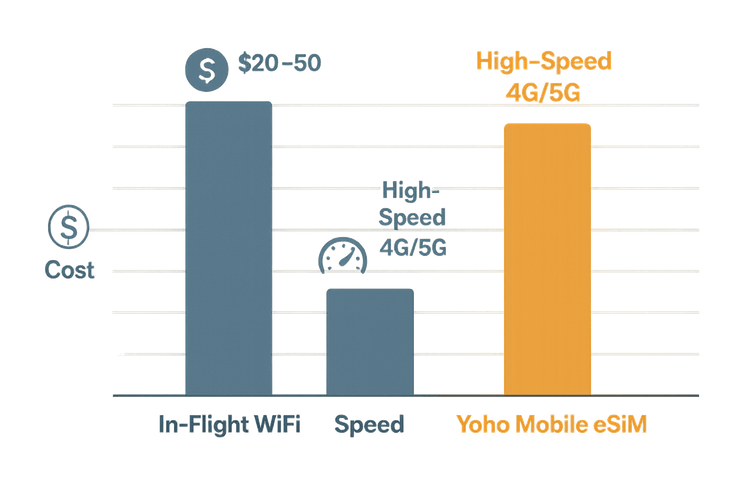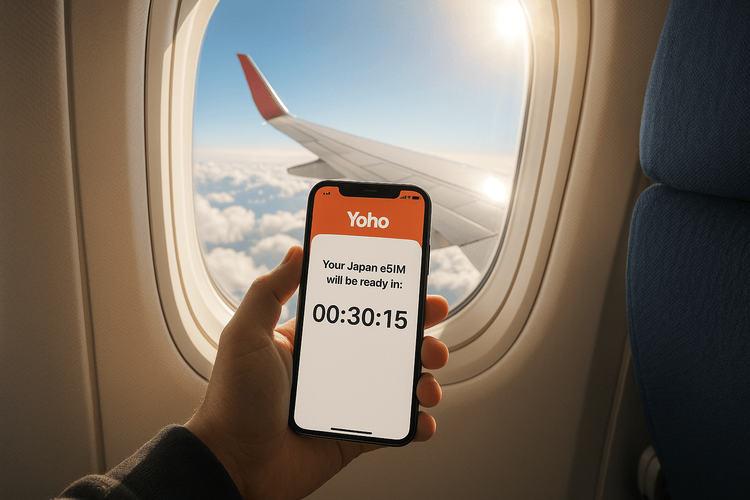Wi-Fi на борту літака проти eSIM: Чи вартий авіаційний Wi-Fi своєї ціни у 2025 році?
Bruce Li•Sep 20, 2025
Ви пристебнуті до крісла під час 12-годинного далекомагістрального перельоту. Початкове захоплення від зльоту зникає, і попереду на вас чекає довгий відрізок часу. Неминуче виникає думка: чи варто платити за Wi-Fi на борту? Він обіцяє зв’язок із зовнішнім світом, але якою ціною та якої якості? Перш ніж діставати кредитну картку на висоті 10 000 метрів, давайте розберемося, чи є авіаційний Wi-Fi розумною витратою, чи краще інвестувати гроші в наземне підключення.
Для більшості сучасних мандрівників відповідь очевидна: eSIM з великим пакетом даних, що чекає на активацію після приземлення, є кращим вибором. Давайте розберемося, чому. Якщо ви новачок у світі eSIM, ви навіть можете спробувати одну безкоштовно, щоб побачити, наскільки безперебійним може бути зв’язок у подорожах.
Висока вартість зв’язку в хмарах
Ціни на авіаційний Wi-Fi часто можуть здаватися непередбачуваними та завищеними. Минули часи простої фіксованої плати. Тепер ви, швидше за все, зіткнетеся з меню опцій, що базуються на тривалості, швидкості або навіть типі додатків, які ви хочете використовувати. Провайдери, такі як Gogo Inflight та Viasat, домінують на ринку, і хоча технології покращилися, моделі ціноутворення відображають ситуацію з обмеженим вибором.
Вартість доступу на весь політ на далекомагістральному міжнародному рейсі може легко коливатися від $20 до понад $50. Деякі авіакомпанії, як-от United Airlines, пропонують різні тарифні плани — базовий план для обміну повідомленнями може бути дешевшим, тоді як преміум-план для перегляду веб-сторінок коштує значно дорожче. Коли ви порівнюєте це з вартістю багатогігабайтного плану eSIM, цінність Wi-Fi на борту починає стрімко падати. Ви можете витратити еквівалент тижневого запасу високошвидкісних даних лише на кілька годин повільного, ненадійного з’єднання.
Реальність продуктивності Wi-Fi на борту
Окрім високої вартості авіаційного Wi-Fi, найбільшою проблемою є його продуктивність. Інтернет передається із супутників на приймач у літаку — процес, який неминуче призводить до високої затримки та обмеженої пропускної здатності, яка потім розподіляється між десятками, а то й сотнями пасажирів.
Що це означає для вас?
- Низька швидкість: Забудьте про перегляд Netflix у 4K. Більшість бортових Wi-Fi-мереж ледве забезпечують швидкість понад 1-5 Мбіт/с, чого ледь вистачає для базового перегляду веб-сторінок та електронної пошти. Відеодзвінки часто неможливі.
- Висока затримка: Затримка в передачі сигналу призводить до помітного відставання, через що дії в реальному часі, як-от обмін повідомленнями, здаються повільними.
- Нестабільне з’єднання: З’єднання може обриватися, коли літак переміщується між зонами покриття супутників.
По суті, ви платите преміум-ціну за інтернет, який нагадує початок 2000-х. Чи краще купувати Wi-Fi в літаку, чи використовувати eSIM? Різниця в продуктивності робить вибір очевидним для всіх, хто потребує надійного інтернету.

Розумніша альтернатива: високошвидкісне підключення з eSIM
Замість того, щоб платити за невтішний досвід на борту, подумайте про перерозподіл цього бюджету на потужний інструмент зв’язку, який ви зможете використовувати одразу після приземлення: eSIM від Yoho Mobile.
An eSIM (вбудована SIM) — це цифрова SIM-карта, яка дозволяє активувати тарифний план стільникового зв’язку без необхідності у фізичній SIM-картці. Для мандрівників це справжня революція. Ви можете придбати та встановити свій тарифний план для країни призначення ще до вильоту з дому. Щойно ви вимкнете режим польоту після приземлення в Токіо, Парижі чи Нью-Йорку, ваш телефон миттєво підключиться до місцевої високошвидкісної мережі.
З Yoho Mobile ви отримуєте більше, ніж просто дані. Наші гнучкі плани дозволяють налаштувати обсяг даних і кількість днів, які вам потрібні, гарантуючи, що ви платите лише за те, що використовуєте. Крім того, з такими послугами, як Yoho Care, ви маєте резервний запас даних, тож ви ніколи не залишитеся повністю без зв’язку, навіть якщо вичерпаєте свій основний пакет. Такого спокою Wi-Fi на борту просто не може запропонувати.

Порівняння: Wi-Fi на борту проти eSIM від Yoho Mobile
Давайте порівняємо їх пліч-о-пліч, щоб побачити явного переможця. Найкраща альтернатива бортовому Wi-Fi — це не лише економія грошей; це отримання значно кращого сервісу.
| Характеристика | Wi-Fi на борту | eSIM від Yoho Mobile |
|---|---|---|
| Вартість | Висока ($20 - $50+ за рейс) | Низька (Плани починаються приблизно з $5) |
| Швидкість | Дуже низька (1-5 Мбіт/с, висока затримка) | Дуже висока (Локальні швидкості 4G/5G) |
| Час дії | Лише на борту літака, в зоні покриття | З моменту приземлення до виїзду з країни |
| Зручність | Громіздкі портали входу, спільна пропускна здатність | Миттєва активація, безперебійний досвід |
| Цінність | Низька - Висока ціна за низьку продуктивність | Висока - Доступна ціна за відмінну продуктивність |
Уявіть, що ви приземляєтеся в Європі після довгого перельоту. Замість того, щоб шукати Wi-Fi в аеропорту чи кіоск з місцевими SIM-картами, ви вже онлайн, замовляєте таксі, перевіряєте карти та повідомляєте родині, що ви безпечно прибули. Це сила підготовки. Ознайомтеся з планами eSIM для вашої наступної подорожі до Європи та відчуйте різницю.
Часті запитання (FAQ)
Скільки зазвичай коштує Wi-Fi на 12-годинному рейсі?
Вартість Wi-Fi на міжнародних рейсах може сильно відрізнятися, але очікуйте заплатити від $20 до $50 за доступ на весь політ у більшості великих авіакомпаній. Деякі можуть пропонувати погодинні пакети за $5-$10, що може швидко накопичитися у велику суму.
Чи можу я використовувати eSIM у літаку?
ESIM надає стільникові дані, тому вона не працюватиме, поки літак знаходиться в повітрі, а ваш телефон у режимі польоту. Стратегія полягає в тому, щоб встановити її та підготувати заздалегідь, щоб ви могли активувати її для миттєвого доступу до Інтернету, щойно ви приземлитеся і вам буде дозволено користуватися стільниковими послугами.
Що краще: купити Wi-Fi в літаку чи використовувати eSIM після приземлення?
Для 99% мандрівників використання eSIM після приземлення набагато краще. Це значно дешевше, пропонує набагато вищі швидкості 4G/5G і забезпечує безперервний зв’язок протягом усієї вашої поїздки, а не лише на кілька годин у літаку.
Як отримати підключення одразу після приземлення мого далекомагістрального рейсу?
Придбайте eSIM від Yoho Mobile для вашого пункту призначення перед поїздкою. Для користувачів iOS встановлення неймовірно просте — просто торкніться «Встановити» після покупки. Для Android ви можете відсканувати QR-код. Після приземлення просто увімкніть лінію eSIM у налаштуваннях телефону, і ви будете онлайн за лічені секунди. Перед покупкою ви завжди можете перевірити наш список пристроїв, сумісних з eSIM, щоб переконатися, що ваш телефон готовий.
Висновок: Витрачайте на землі, а не в повітрі
Хоча спокуса переглядати соціальні мережі під час довгого перельоту велика, висока вартість і низька продуктивність Wi-Fi на борту роблять його розкішшю, яка рідко виправдовує свої обіцянки. Якщо у вас немає термінового, критичного за часом робочого завдання, яке абсолютно не може чекати, ці гроші краще витратити інакше.
Інвестуючи в eSIM від Yoho Mobile, ви купуєте не просто кілька годин нестабільного інтернету; ви інвестуєте в безперебійний, високошвидкісний і безстресовий початок вашої подорожі. Ви отримуєте свободу навігації, спілкування та дослідження з моменту приземлення. Для вашої наступної подорожі зробіть розумний вибір для свого гаманця та свого спокою.
